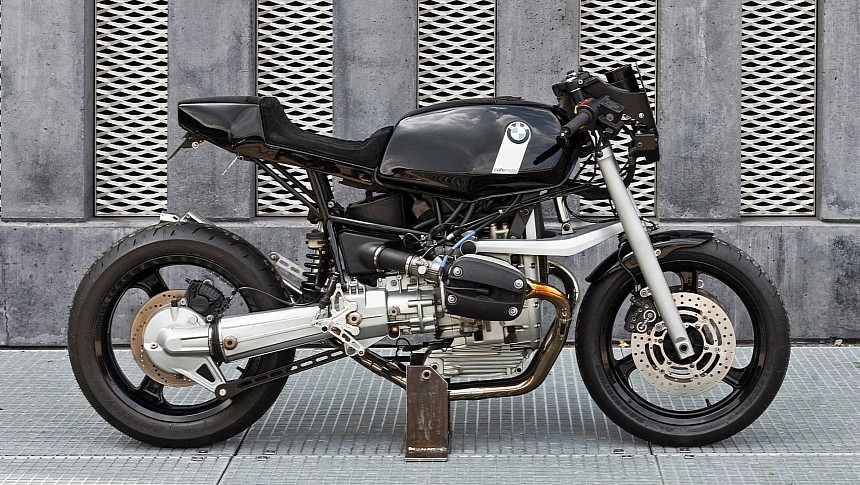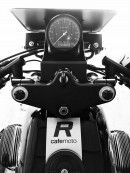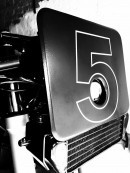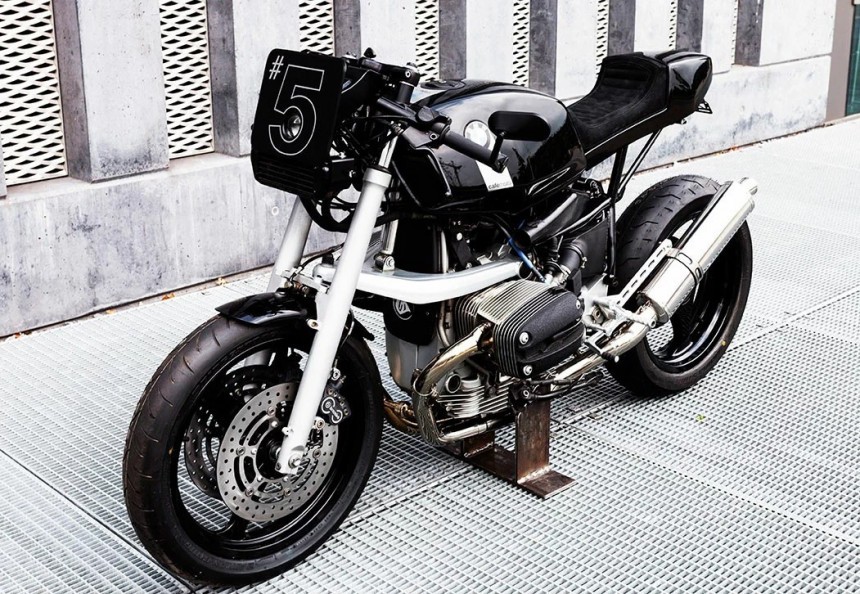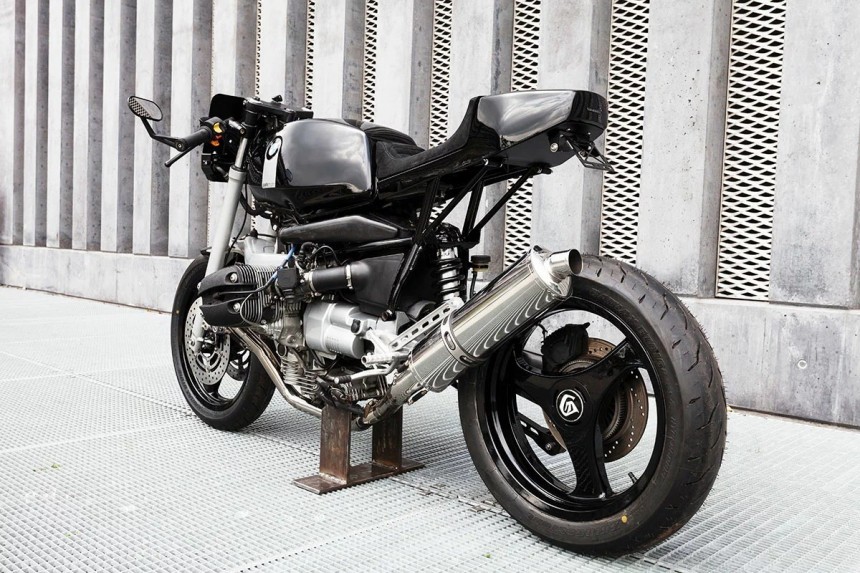Produced by BMW between 1993 and 2001, the R 1100 RS was a truly great offering in the sport-touring segment. Its air- and oil-cooled 1,085cc boxer came with a very respectable 90 hp on tap, while Motorrad’s proprietary Telelever front suspension made for an exceptionally smooth ride. Despite this, the Oilhead was far from light, weighing in at 527 pounds (239 kg) before fluids are taken into account.
Add the said consumables to the equation, and that number grows to an even heftier 564 pounds (256 kg) – in short, not what you’d refer to as nimble. Given its weight and rather bulky anatomy, most custom bike builders wouldn’t touch the R 1100 RS with a ten-foot pole. That’s understandable; I mean, one cannot possibly turn this heavy, fully-faired touring model into a stripped-down ripper, right?
Well, there are a couple of dudes over in Gelsenkirchen, Germany who would thoroughly disagree. We’re talking about Georg Godde and Holger Maninger, who operate as Cafemoto specializing in BMW conversions of all shapes and sizes. If there was anyone out there who could put the R 1100 RS on a real diet, they were most certainly the perfect guys for the job.
Georg and Holger kicked things off with a 1993 model, subjecting it to a dramatic weight reduction and doing away with a ton of visual mass. As the donor was being taken apart, all its stock bodywork was politely shown the way to the trash can, but Cafemoto chose not to mess with the front or rear suspension.
Although this may surprise you, it’s worth noting that BMW’s Telelever and Paralever suspension arrangements tend to get quite a bit of praise. They’re said to be great at absorbing road bumps, and Cafemoto didn’t see the need for any upgrades in this department. Internally, the motorcycle’s boxer-twin engine is also unmodified, because adding lightness was the name of the game here.
Starting at the front end, we first come across a handmade number plate built around a single LED projector light. The oil cooler is now located right beneath these parts, living inside a custom bracket with Motogadget turn signals flanking it on each side. You’ll notice a new front fender lower down, a slimmer and lighter alternative to the factory unit once placed in that area.
It sits above a replacement three-spoke wheel measuring 18 inches in diameter, and whose rim carries a 110/90 Bridgestone Battlax tire. The same rubber is present at the back, its dimensions being 150/70 this time around. In the cockpit, you will find a Motogadget Chronoclassic dial taking pride of place center-stage, neatly placed inside a CNC-machined aluminum bracket.
This is the same bracket which holds the number plate, attaching to the underside of a custom top clamp. Staying true to their name, Cafemoto added a pair of Telefix clip-ons to caffeinate the R 1100’s ergonomics, and they subsequently dressed them up in LSL grips. A single bar-end mirror was installed on the left-hand side.
Moving southward, we see the repurposed gas tank of a BMW R45, but this part required some intricate tweaks before it could fit. Georg and his accomplice revised its bottom section to accommodate the stock fuel pump, while shaping it in a way which suited the frame of its new host. Behind the R45 tank, the Germans fitted a cafe-style tail and seat pan combo, finishing it off with a bespoke saddle wrapped in black suede.
The whole affair is supported by a modified subframe, and the tail’s rearmost portion houses an LED taillight and a bare-bones license plate bracket. A bit further ahead, one may spot tiny aftermarket blinkers completing the rear-end lighting hardware. On their quest to shave off as much weight as possible, the Cafemoto duo ditched the original battery in favor of a much lighter LiFePO4 replacement.
They sought some extra stopping power, too, so a fresh set of aftermarket brake discs have been invited to join the party up front. Furthermore, there are braided stainless-steel brake lines all-round. Holger and Georg also added billet foot pegs to the equation, and they didn’t let the creature’s twin-cylinder boxer escape completely untouched, either.
Nology spark plugs were installed just for good measure, but the new exhaust system is clearly the star of the show here. It’s a two-into-one ordeal developed by Rennkuh, a boutique German exhaust manufacturer specializing in BMW boxers. Lastly, it came time for Cafemoto to settle on a suitable colorway.
In the end, they went with an austere, yet nicely executed mixture of black and white. We said something about a considerable drop in weight earlier, though, and this is perhaps the most impressive part of the workshop’s overhaul. Following their transformation, the motorcycle is said to weigh just 441 pounds (200 kg) fully-loaded, a whopping 123 pounds (56 kg) lighter than stock!
Well, there are a couple of dudes over in Gelsenkirchen, Germany who would thoroughly disagree. We’re talking about Georg Godde and Holger Maninger, who operate as Cafemoto specializing in BMW conversions of all shapes and sizes. If there was anyone out there who could put the R 1100 RS on a real diet, they were most certainly the perfect guys for the job.
Georg and Holger kicked things off with a 1993 model, subjecting it to a dramatic weight reduction and doing away with a ton of visual mass. As the donor was being taken apart, all its stock bodywork was politely shown the way to the trash can, but Cafemoto chose not to mess with the front or rear suspension.
Although this may surprise you, it’s worth noting that BMW’s Telelever and Paralever suspension arrangements tend to get quite a bit of praise. They’re said to be great at absorbing road bumps, and Cafemoto didn’t see the need for any upgrades in this department. Internally, the motorcycle’s boxer-twin engine is also unmodified, because adding lightness was the name of the game here.
It sits above a replacement three-spoke wheel measuring 18 inches in diameter, and whose rim carries a 110/90 Bridgestone Battlax tire. The same rubber is present at the back, its dimensions being 150/70 this time around. In the cockpit, you will find a Motogadget Chronoclassic dial taking pride of place center-stage, neatly placed inside a CNC-machined aluminum bracket.
This is the same bracket which holds the number plate, attaching to the underside of a custom top clamp. Staying true to their name, Cafemoto added a pair of Telefix clip-ons to caffeinate the R 1100’s ergonomics, and they subsequently dressed them up in LSL grips. A single bar-end mirror was installed on the left-hand side.
Moving southward, we see the repurposed gas tank of a BMW R45, but this part required some intricate tweaks before it could fit. Georg and his accomplice revised its bottom section to accommodate the stock fuel pump, while shaping it in a way which suited the frame of its new host. Behind the R45 tank, the Germans fitted a cafe-style tail and seat pan combo, finishing it off with a bespoke saddle wrapped in black suede.
They sought some extra stopping power, too, so a fresh set of aftermarket brake discs have been invited to join the party up front. Furthermore, there are braided stainless-steel brake lines all-round. Holger and Georg also added billet foot pegs to the equation, and they didn’t let the creature’s twin-cylinder boxer escape completely untouched, either.
Nology spark plugs were installed just for good measure, but the new exhaust system is clearly the star of the show here. It’s a two-into-one ordeal developed by Rennkuh, a boutique German exhaust manufacturer specializing in BMW boxers. Lastly, it came time for Cafemoto to settle on a suitable colorway.
In the end, they went with an austere, yet nicely executed mixture of black and white. We said something about a considerable drop in weight earlier, though, and this is perhaps the most impressive part of the workshop’s overhaul. Following their transformation, the motorcycle is said to weigh just 441 pounds (200 kg) fully-loaded, a whopping 123 pounds (56 kg) lighter than stock!
